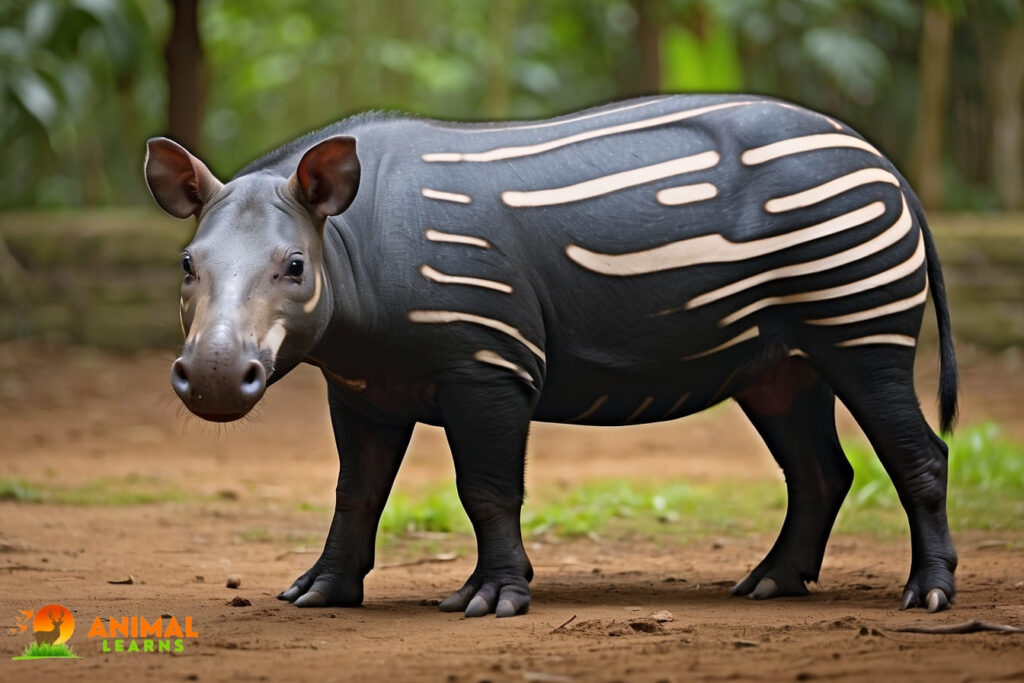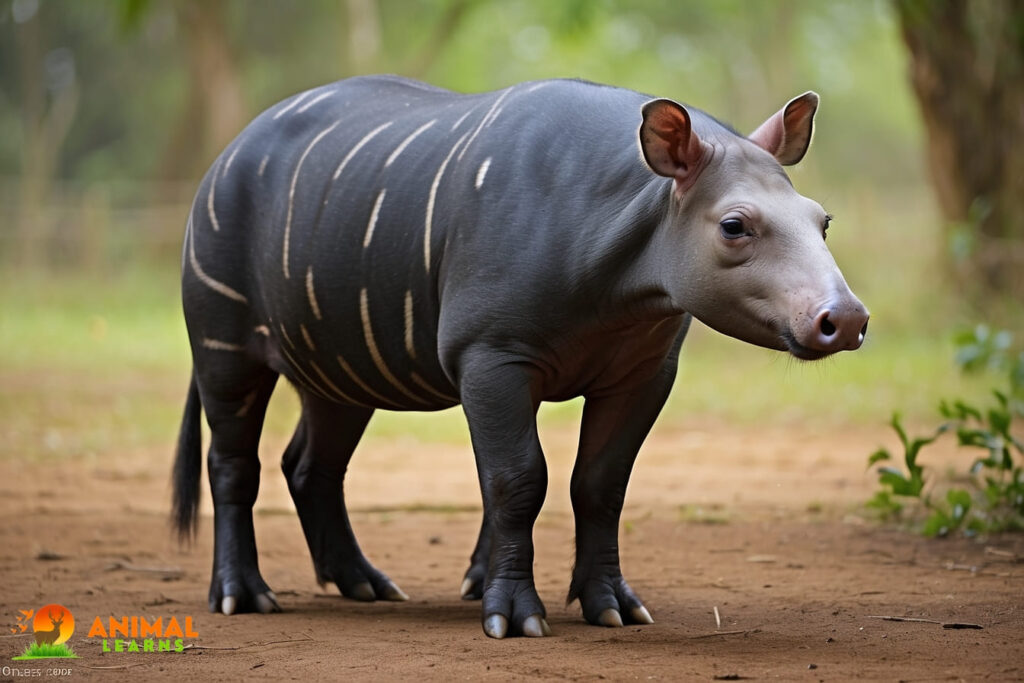Brazilian Tapirs: Types, And Interesting Facts

| Attribute | Information |
| Scientific Name | Tapirus terrestris |
| Size | Approximately 2004.97 mm (length) |
| Weight | Typically between 150 to 320 kg |
| Color | Dark brown to grayish-black with a whitish crest on their throat, chest, and belly |
| Running Speed | Can reach speeds of up to 30 km/h (18.6 mph) |
| Diet | Herbivorous, primarily consuming leaves, fruits, and aquatic vegetation |
| Location | Endemic to the rainforests of South America, particularly in countries like Brazil, Venezuela, Colombia, and Peru |
One of four tapir species and a fascinating cousin of the rhinoceros is the Brazilian tapirs, also known as the lowland tapir. Its prehensile, multipurpose, fleshy trunk, which functions as a snorkel while it swims, is what makes it most unique.
These tapirs, which are native to the rainforests of South America, are skilled swimmers and divers who frequently use the water to elude predators. Their environment is swampy, and their splayed toes—three on the hindfoot and four on the front—help them travel.
Known by their scientific name, Tapirus terrestris, they are classified in CITES Appendix II and considered vulnerable by the IUCN. These lone omnivores may reach a maximum length of 2004.97 mm and an amazing longevity of up to 420 months.
history of Brazilian tapirs
Contents
- 1 history of Brazilian tapirs
- 2 The appearance
- 3 Diet
- 4 Habitat And Distribution
- 5 Characteristics of Brazilian Tapirs
- 6 Types of Brazilian tapirs
- 7 Interesting Facts of Brazilian Tapirs
- 8 Behavior And Lifestyle
- 9 Adaptations
- 10 Population
- 11 Social systems
- 12 Predators
- 13 Mating
- 14 Diseases
- 15 Challenges faced
- 16 FAQs
The complex biological tapestry of South America is woven together with the history of Brazilian tapirs, commonly referred to as lowland tapirs. Over millions of years, these massive, herbivorous animals have wandered the continent, developing special adaptations like their prehensile snouts.
Although it is difficult to pinpoint their exact origins, they have played a significant role in the grasslands, marshes, and rainforests of South America. However, habitat degradation, poaching, and human encroachment have presented them with serious difficulties recently.
In order to guarantee the survival of Brazilian tapirs in the wild, conservation efforts and the preservation of their natural habitats are becoming more and more important.
The appearance

Brazilian tapirs, sometimes referred to as lowland tapirs, have a characteristic look. They are muscular, big creatures with a glossy coat that ranges from dark brown to grayish-black. The white crest that extends around their abdomen, breast, and throat is a prominent characteristic that stands out against their mostly black coloring.
These tapirs are also known for their big lips an long nose, which help them grasp and manipulate food with precision using their elongated prehensile snout.
Their most notable physical characteristic is their prehensile, flexible, fleshy stem, which they employ for a variety of purposes, including swimming and leaf-grasping.
Diet
Tapirs from Brazil are herbivores that eat a variety of foods. Their main food sources include leaves, fruits, and aquatic plants. They are mostly found in South America’s deep jungles, where their nutrition is crucial to their existence.
Habitat And Distribution
The tropical jungles of South America are the natural habitat of Brazilian tapirs. They live near rivers, streams, and other bodies of water in nations including Peru, Colombia, Venezuela, Brazil, and Venezuela.
Their extensive spread throughout the Neotropics is indicative of their adaptation to different rainforest habitats.
Characteristics of Brazilian Tapirs

- Brazilian tapirs are distinguished by their prehensile, extended nose, or proboscis, and by their sturdy body and short legs. They have a white “saddle” or patch on their back and brownish-gray fur.
- Found in Bolivia, Brazil, Argentina, Paraguay, and other regions of South America.
- They live in a variety of habitats, such as marshes, grasslands, and rainforests.
- In order to escape predators and keep cool in hot regions, Brazilian tapirs are mostly active at night.
- They consume only aquatic plants, leaves, and fruits as food.
- Tapirs are timid and evasive creatures who spend most of their time alone.
- Brazilian tapirs are frequently seen in and around bodies of water, where they utilize their swimming prowess to fend off predators and control their body temperature.
- Because of habitat destruction and poaching for their meat and skin, they are thought to be in risk of going extinct.
- Females usually give birth to a single calf after a lengthy gestation period of around 13 months.
- By spreading seeds from the fruits they eat, Brazilian tapirs contribute significantly to the ecosystem of forests.
Types of Brazilian tapirs
The Tapirus terrestris, or Brazilian tapir, is one of the four species of tapirs that may be found worldwide. Another name for them that is frequently used is Lowland tapir. The other three species are the Mountain tapir, the Malayan tapir, and the Baird’s tapir.
Each species has distinct traits and adaptations to fit into its particular environment. As its name implies, Brazilian tapirs are mostly found in South America’s lowland jungles, particularly those in the Amazon region.
Interesting Facts of Brazilian Tapirs

- Unique Appearance: The huge, barrel-shaped body and prehensile, proboscis-like nose of Brazilian tapirs are characteristics that set them apart from other animals. They can better hold leaves and fruits in their home of thick jungle because to their snout.
- Solitary Creatures: Tapirs are primarily solitary creatures who like living alone. Being most active in the early morning and late evening, they are difficult to observe in the wild due to their elusive and secretive character.
- Keystone Species: As seed dispersers, tapirs are essential to rainforest ecosystems. They eat a wide range of fruits and seeds, and through their excrement, they spread seeds that aid in the regeneration of the forest.
- Nocturnal Behavior: Brazilian tapirs are mostly nocturnal animals that spend the day sleeping in thick foliage and waking up earlier to hunt.
Behavior And Lifestyle
Being mostly solitary creatures, these tapirs are most active at night. Their vision is not very good, so they have to rely on their excellent sense of hearing and smell to get about.
The Brazilian tapir is renowned for its swiftness, reaching up to 30 km/h on foot. Their quickness is useful when they have to flee from danger or prospective predators.
Adaptations
The most amazing adaption of the Brazilian tapir is its adaptable prehensile trunk. This special characteristic serves as a snorkel for them while they swim in addition to being utilized to grab leaves and fruits. They can stay immersed in water or reach food by extending and manipulating their trunk.
They are well adaptable to their difficult rainforest habitat because of their adaption, which enables them to flourish in both terrestrial and aquatic settings.
Population
Although the number of Brazilian tapirs fluctuates across their territory in South America, habitat degradation and poaching are the main causes of their vulnerability. Because populations are elusive, it can be difficult to establish accurate estimates of them.
In certain locations, conservation initiatives and protected areas have contributed to the preservation and growth of these species. The Amazon rainforest is home to the majority of their population since it provides them with plenty of food and shelter.
Social systems
Brazilian tapirs are solitary animals by nature, as was previously established. Since they are solitary creatures, each one usually has a home range that it guards from outsiders. Males often have bigger territories, which might overlap with many females’ territories.
To prevent needless confrontations, tapirs utilize scent markers and vocalizations to designate their territory and communicate with one another.
Males and females in their region may contact during the mating season, but long-term relationships are not formed. Females give birth to a single calf after a comparatively lengthy gestation period of almost 13 months, and they raise it until it can stand on its own.
Predators
Despite being big, dangerous creatures, Brazilian tapirs do have some natural predators. Tapirs in the Amazon jungle are mostly threatened by jaguars.
These big cats are formidable hunters that can take down even the strong tapirs. Furthermore, juvenile tapirs are more susceptible to being eaten by larger snakes like anacondas.
Mating
Lowland tapirs (Tapirus terrestris), commonly referred to as Brazilian tapirs, are solitary and evasive when it comes to mating. During the breeding season, they gather together instead of forming permanent couples. When food is plentiful during the rainy season, mating usually takes place.
Typically, female tapirs give birth to a single calf throughout their roughly 13-months gestation period. The infant tapir spends around a year with its mother, who gives it care and protection while teaching it vital survival skills.
Diseases
Like many other animal species, Brazilian tapirs are vulnerable to a number of illnesses that might have an impact on their population. They are more vulnerable to stress and human interaction as a result of habitat loss and fragmentation, which raises their chance of contracting illnesses including zoonotic and parasitic infections.
In order to keep these tapirs safe, efforts are frequently directed toward keeping an eye on their health and offering assistance when required. To preserve the existence of this rare species, conservationists strive to lessen the effects of illnesses and other dangers.
Challenges faced

Brazilian tapirs have several difficulties in the contemporary world. One of the biggest risks to their existence is habitat damage brought on by deforestation and human development. Tapirs are more susceptible to poaching, auto accidents, and conflicts between humans and wildlife as their natural habitats become smaller.
Their well-being may also be impacted by climate change and its effects on food availability and weather patterns. In order to maintain these amazing species’ long-term survival in the wild, conservation efforts are primarily focused on safeguarding their habitats, minimizing human disruptions, and increasing public awareness of the need to do so.
FAQs
What is a Brazilian tapir?
A Brazilian tapir, also known as a lowland tapir, is a large herbivorous mammal found in South America. It is one of four tapir species and is known for its distinctive prehensile snout.
Where do Brazilian tapirs live?
Brazilian tapirs primarily inhabit the dense rainforests, swamps, and grasslands of South America, with a range extending from Venezuela to Argentina.
What do Brazilian tapirs eat?
They are herbivores and mainly consume a diet of leaves, fruits, aquatic vegetation, and other plant materials.
Are Brazilian tapirs endangered?
Yes, Brazilian tapirs are listed as a vulnerable species. They face threats from habitat loss due to deforestation and hunting, and conservation efforts are vital for their survival.
How long do Brazilian tapirs live in the wild?
In the wild, Brazilian tapirs have an average lifespan of 25 to 30 years. In captivity, they can live even longer, often reaching up to 35 years or more.












